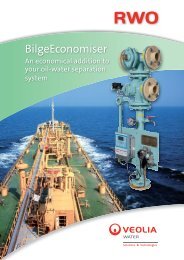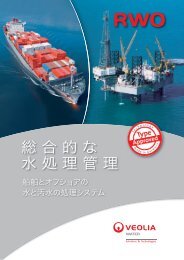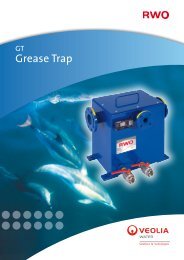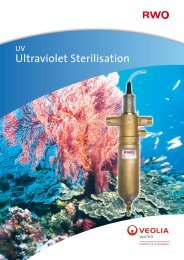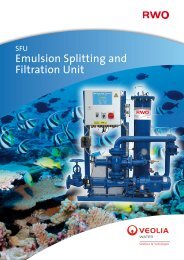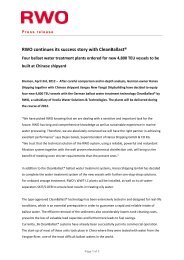the IHS Ballast Water Guide - RWO Marine Water Technology
the IHS Ballast Water Guide - RWO Marine Water Technology
the IHS Ballast Water Guide - RWO Marine Water Technology
You also want an ePaper? Increase the reach of your titles
YUMPU automatically turns print PDFs into web optimized ePapers that Google loves.
Sponsored by <strong>IHS</strong> Fairplay Solutions <strong>Guide</strong> to <strong>Ballast</strong> <strong>Water</strong> Treatment Systems<br />
own symbol as shown in <strong>the</strong> key below.<br />
Descriptions of each of <strong>the</strong> systems that<br />
appear in Table 3 are also provided, designated<br />
with <strong>the</strong> symbol for its technology type.<br />
Disinfection by-products are an issue, and<br />
Treatment technology type and symbol<br />
Mechanical<br />
1 Cyclonic separation (hydrocyclone)<br />
2 Filtration<br />
Chemical treament and biocides<br />
1 Clorination<br />
2 Chloride dioxide<br />
3 Advanced oxidation<br />
4 Residual control (sulphite/bisulphate)<br />
5 Peraclean Ocean<br />
concentration of at least 2mg a litre is used.<br />
Ozone gas, which is bubbled through <strong>the</strong><br />
water, is effective at killing micro-organisms.<br />
It produces a bromate by-product and<br />
requires an ozonate generator.<br />
Chlorine dioxide is effective, particularly<br />
in high-turbidity waters. It has a half-life of<br />
six to 12 hours, but, according to suppliers,<br />
can be safely discharged within 24 hours.<br />
Physical disinfection<br />
When ultraviolet irradiation is used, amalgam<br />
<strong>the</strong>y are central to <strong>the</strong> approval of systems<br />
that employ an active substance. Generally,<br />
<strong>the</strong>se systems treat on uptake only, with<br />
<strong>the</strong> exception of those that use neutralising<br />
agents before discharge.<br />
Physical Ph disinfection<br />
1 Coagulation/flocculation<br />
2 Ultrasound<br />
3 Ultraviolet<br />
4 Heat<br />
5 Cavitation<br />
6 Deoxygenation<br />
7 Electro-chlorination/electrolysis<br />
8 Electro-catalysis<br />
9 Ozonation<br />
lamps surrounded by quartz sleeves produce<br />
UV light, which changes <strong>the</strong> molecular<br />
structure of <strong>the</strong> organism and <strong>the</strong>reby<br />
prevents it from reproducing.<br />
The deoxygenation method relies on<br />
reducing <strong>the</strong> pressure of oxygen in <strong>the</strong> space<br />
above <strong>the</strong> water by injecting an inert gas or<br />
inducing a vacuum. The removal of oxygen<br />
may also lead to a reduction in corrosion.<br />
If heat is employed to treat <strong>the</strong> ballast<br />
water, <strong>the</strong> water can be used to provide<br />
engine cooling while being disinfected.<br />
© <strong>IHS</strong> Global Limited 2012 11<br />
010_011_corrected BW1204.indd 11 01/08/2012 15:46:53<br />
Photo: iStock



